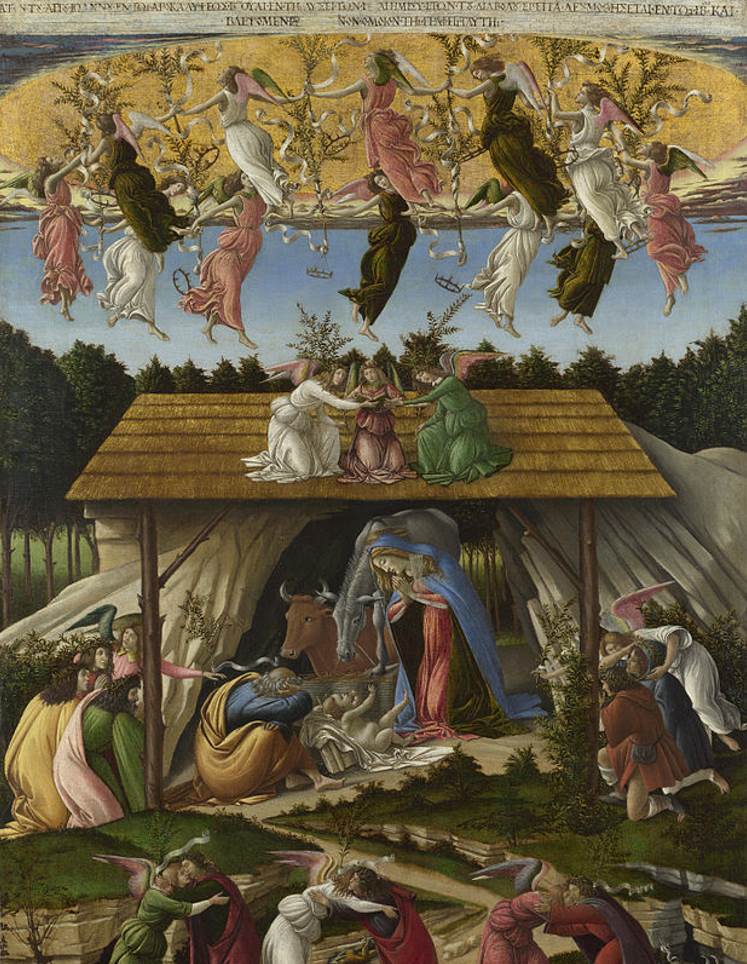The paintings of this Master of the Renaissance were forgotten for centuries until an artistic group revived his oeuvre in England.
Sandro Botticelli (1445-1510) was an Italian artist from Florence who spent most of his life in his home city (although he produced some famous works in Rome as well).
His style can be described as an extension of the ideals of Gothic artists with a mix of Renaissance features that transformed art history indefinitely.
He produced some of the most iconic and famous Renaissance paintings in history and his reputation got a massive boost because of the Pre-Raphaelites in England starting in 1848.
In this article, you’ll discover some of the most famous paintings by Sandro Botticelli.
1. The Birth of Venus
- Date created: 1484-1486
- Dimensions: 172.5 × 278.9 centimeters (67.9 × 109.6 inches)
- Location: Uffizi Gallery, Florence, Italy
The Birth of Venus is without a doubt the most famous painting by Botticelli. It’s one of the most iconic paintings of the Renaissance and depicts the classical scene of Venus arriving on shore following her birth as a fully grown woman. The pose she strikes is known as “Venus Anadyomene.”
The painting was completed in the 1480s, at the height of the Renaissance and a time when large-scale works depicting mythological scenes were still pretty uncommon. This is just one way in which Sandro Botticelli transformed the world of art as he was followed by countless artists of future generations.
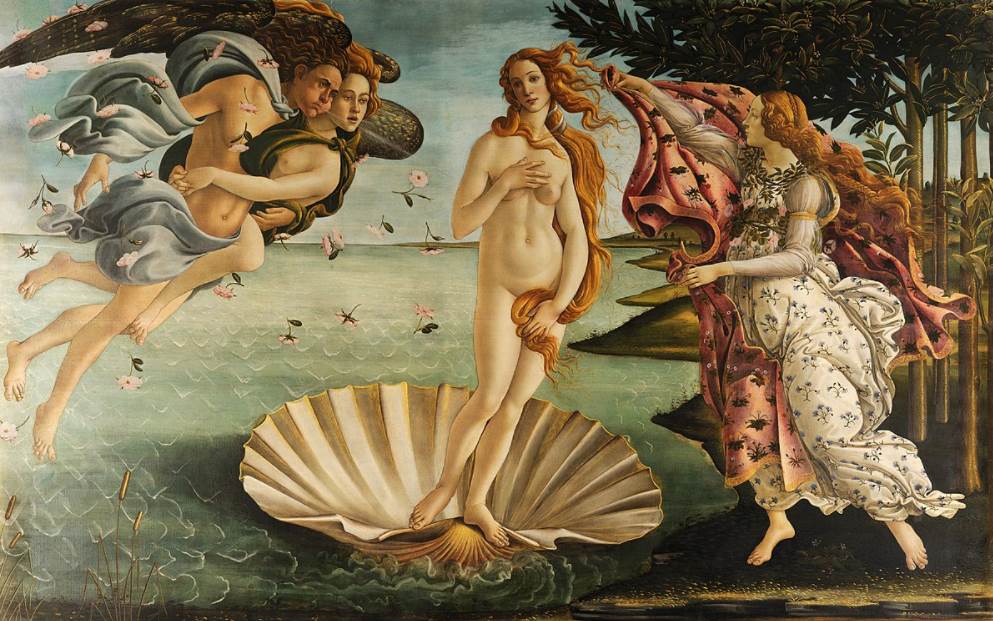
2. Primavera
- Date created: Late 1470s – Early 1480s
- Dimensions: 202 × 314 centimeters (80 × 124 inches)
- Location: Uffizi Gallery, Florence, Italy
Primavera is another monumental painting by Botticelli and it can be described as the most ambiguous of his career. The main reason is that art historians are still debating the subject matter and still haven’t come to a definite conclusion as to what it’s really about.
The painting depicts a large number of figures from classical antiquity in a garden but there seems to be no unified theme that brings them together. Although this Venus painting hangs together with The Birth of Venus at the Uffizi Gallery, they are not considered to be a pair.

3. Portrait of a Lady Known as Smeralda Brandini
- Date created: 1475
- Dimensions: 65.7 × 41 centimeters (25.9 × 16 inches)
- Location: Victoria & Albert Museum, London, United Kingdom
Portrait of a Lady Known as Smeralda Brandini is the title of one of the many portraits that Sandro Botticelli completed during his long career. The depicted woman is believed to be Smeralda Brandini based on an inscription on the windowsill at the bottom of the work.
If this is true, it means this was the grandmother of Baccio Bandinelli (1493-1560), a famous Renaissance sculptor of the 16th century. This portrait is remarkable for both the strong gaze of the woman and the three-quarter pose, the first of its kind by the Italian artist.

4. Venus and Mars
- Date created: 1485
- Dimensions: 69 x 173.5 centimeters (27.1 x 68.3 inches)
- Location: National Gallery, London, United Kingdom
Venus and Mars is another world-famous painting by Botticelli which depicts the Roman goddess of love Venus and the Roman god of war Mars. The painting is believed to be a metaphorical representation of beauty and courage, the characteristics that define these deities.
What’s remarkable about this painting is the wide format which was uncommon at the time. This has made art historians conclude that it was probably a wedding gift that was intended to be placed in the groom and bride’s bedroom. It’s likely that it was part of a series of paintings as well.
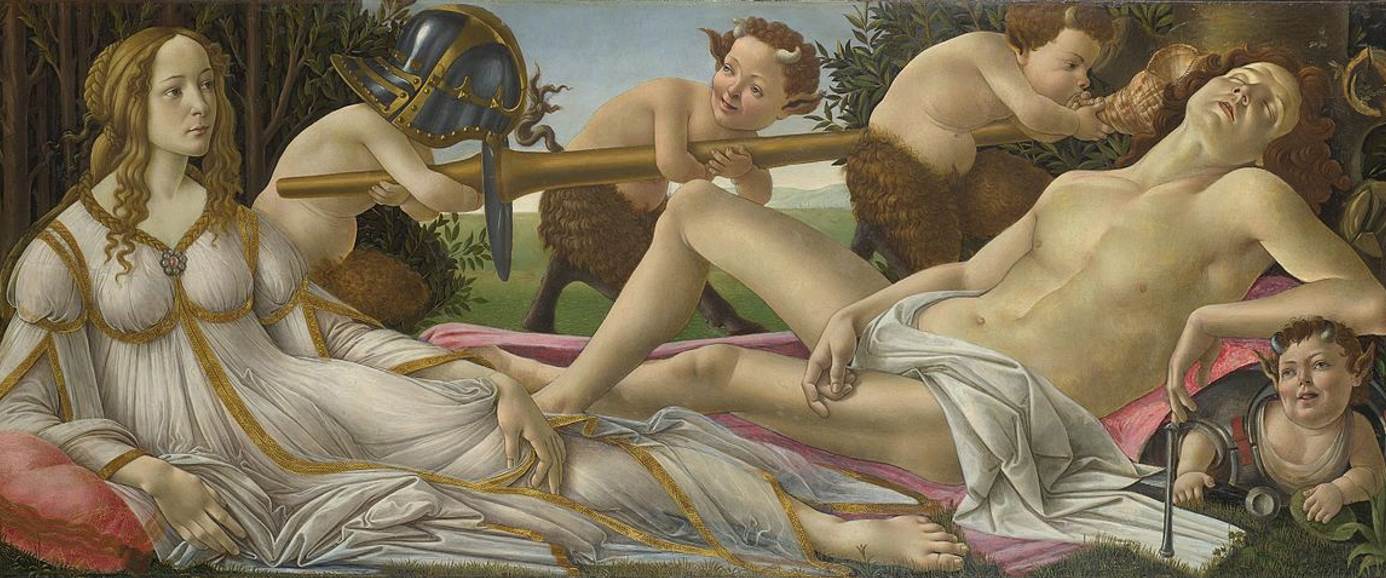
5. Adoration of the Magi
- Date created: 1475-1476
- Dimensions: 111 × 134 centimeters (44 × 53 inches)
- Location: Uffizi Gallery, Florence, Italy
Adoration of the Magi is the title of a painting that depicts a common subject in the history of art. According to the Biblical story in the Gospel of Matthew, the Three Magi or Three kings visited the newly born Jesus Christ after following a star in the sky. The work is characterized by a presumed self-portrait of the artist who stands on the utmost right side of the work facing the viewer.
The painting was commissioned to decorate the chapel of a wealthy Florentine man named Gaspare di Zanobi del Lama who had a chapel in the Santa Maria Novella church in Florence. It served as the altarpiece of this chapel and stayed there for 100 years. It was moved to its current location at the Uffizi Gallery in 1796.
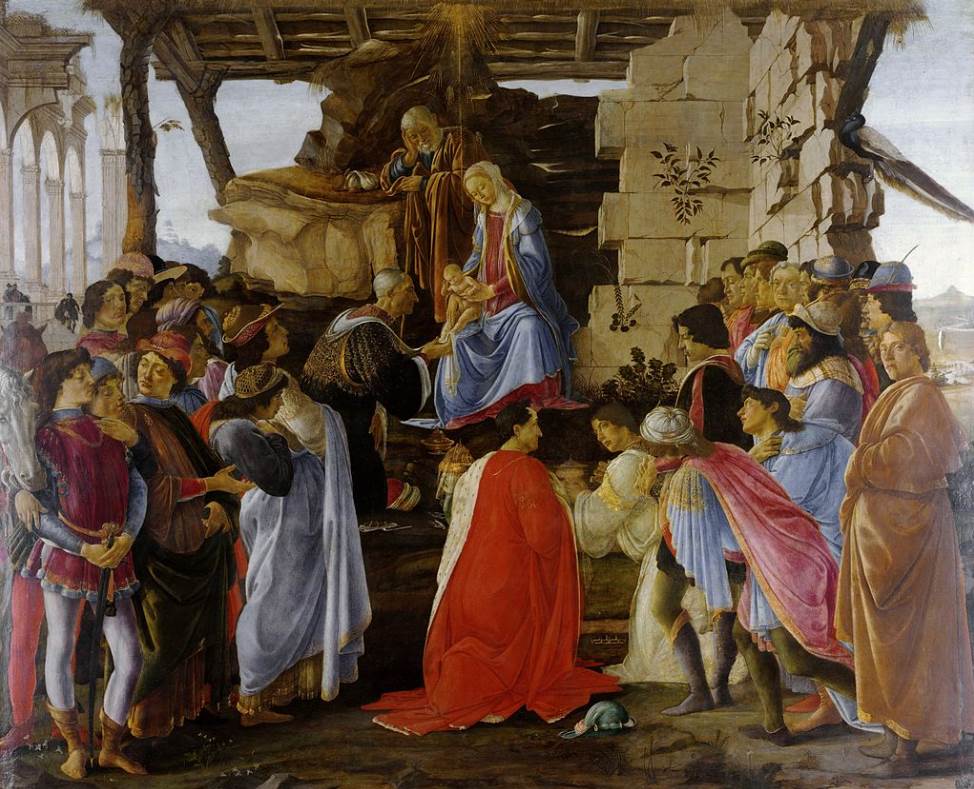
6. Youth of Moses
- Date created: 1481-1482
- Dimensions: 348.5 × 558 centimeters (137.2 × 220 inches)
- Location: Sistine Chapel, Rome, Italy
The Youth of Moses or “The Trials of Moses” is the title of a monumental fresco that decorates the interior of the Sistine Chapel in Rome. It’s one of several frescoes produced by Florentine artists that are located here and are often overshadowed by Michelangelo’s works such as the Sistine Chapel Ceiling and the Last Judgement.
By the early 1480s, the reputation of Botticelli in his native Florence was so great that he was one of the artists who was sent to Rome as part of a diplomatic mission. Florentine ruler Lorenzo de’ Medici tried to make peace with Pope Sixtus IV by having his artists produce amazing works at the Apostolic Palace. This fresco depicts several scenes from the life of Moses derived from Exodus.
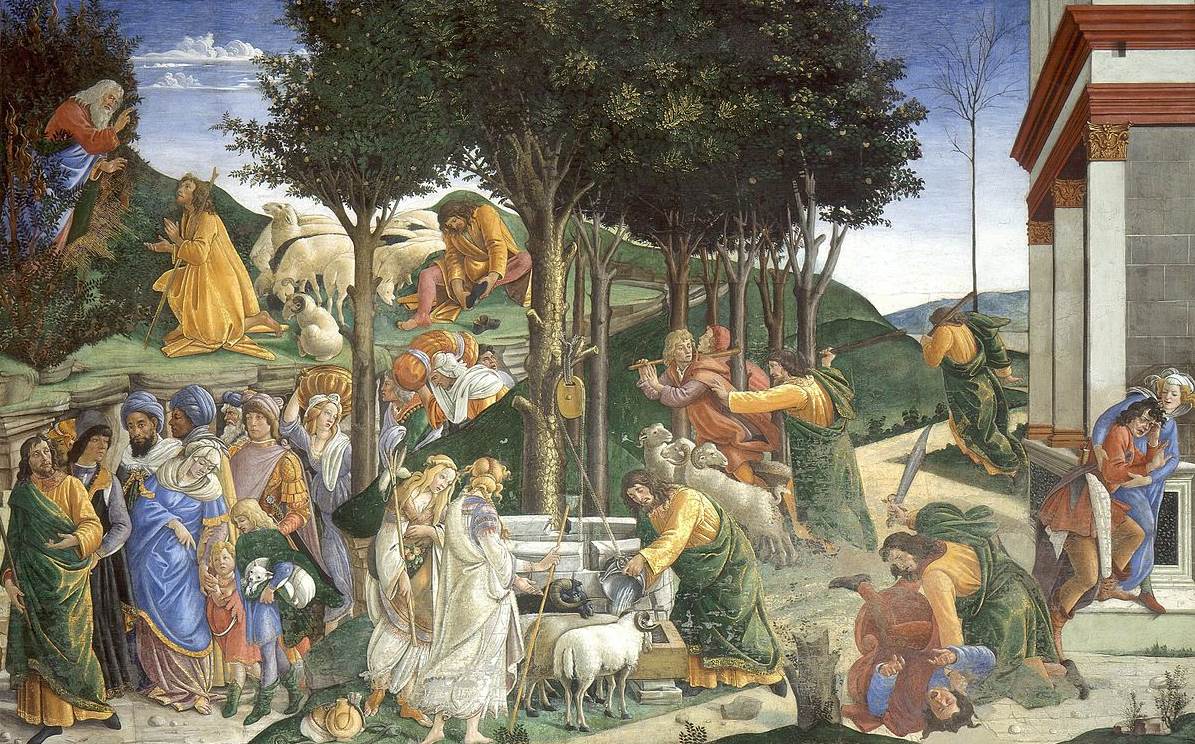
7. Punishment of the Sons of Korah
- Date created: 1480-1482
- Dimensions: 348.5 × 570 centimeters (137.2 × 220 inches)
- Location: Sistine Chapel, Rome, Italy
The Punishment of the Sons of Korah is also known as “Punishment of the Rebels” and is another monumental fresco that Botticelli completed during his stay in Rome. It’s also located in the Sistine Chapel, the chapel of the Apostolic Palace in Vatican City.
This work depicts three scenes from the life of Moses, including the Israelite rebellion against Moses and Aaron. The large Roman triumphal arch was modeled on the Arch of Constantine which stands right next to the Colosseum in Rome.
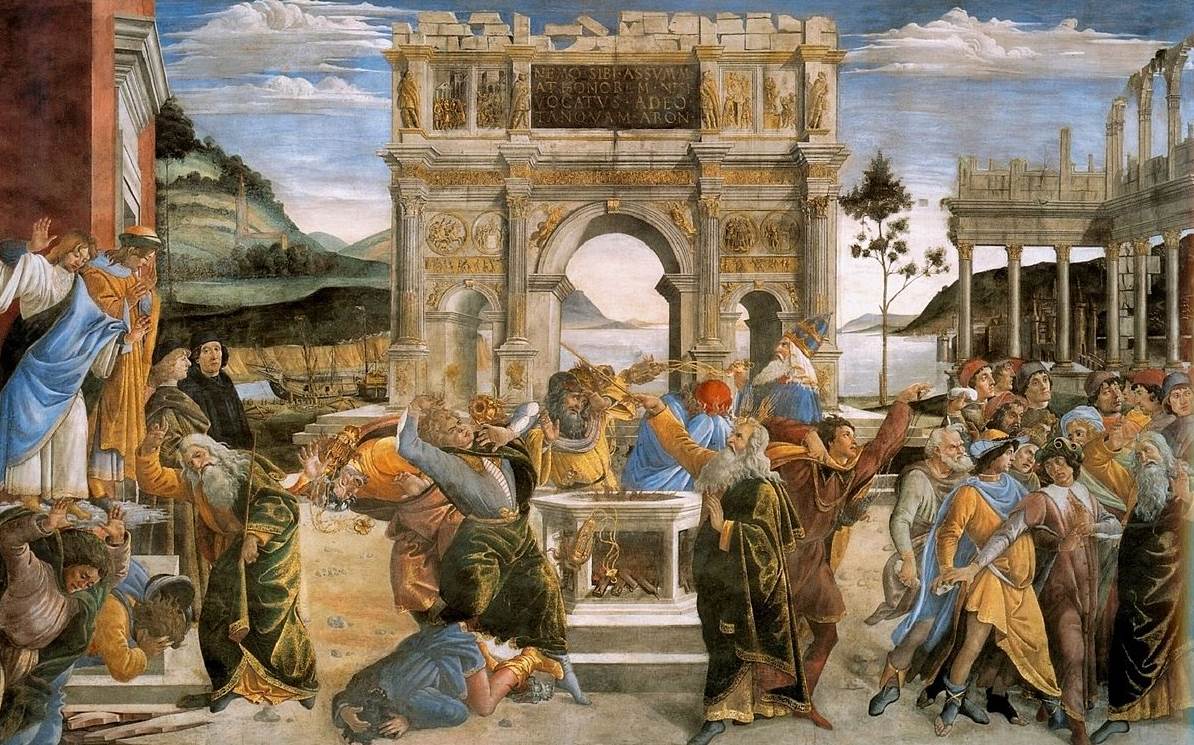
8. Madonna of the Magnificat
- Date created: 1481
- Dimensions: 118 × 119 centimeters (46 × 47 inches)
- Location: Uffizi Gallery, Florence, Italy
Madonna of the Magnificat is the common title of a painting also known as Virgin and Child with Five Angels. It’s one of several tondo paintings that Botticelli completed during his career and depicts the Virgin Mary being crowned by a number of angels as she holds her infant Jesus Christ.
Nothing is known about the early history of this painting and it only surfaced in the late 18th century when it was acquired by the Uffizi Gallery where it remains today. The title of the painting refers to Mary’s writing of the first verse of the Magnificat, also known as “The Song of Mary.”

9. Calumny of Apelles
- Date created: 1494-1495
- Dimensions: 62 × 91 centimeters (24 × 36 inches)
- Location: Uffizi Gallery, Florence, Italy
The Calumny of Apelles is another painting by Botticelli that features an abundance of architectural marvels. It’s believed to be a replica of a lost painting by Apelles of Kos (4th century B.C.), an ancient Greek painter, based on a description of this ancient work.
Many of his paintings show the interest that Botticelli had in ancient Greek art and he aimed to recreate the former glory of these ancient works. This notion is emphasized by the fact that the small size of this work has led art historians to believe that he produced this work for his personal collection.

10. The Mystical Nativity
- Date created: 1500-1501
- Dimensions: 108.5 × 74.9 centimeters (42.7 × 29.5 inches)
- Location: National Gallery, London, United Kingdom
The Mystical Nativity is the title of a painting that was completed in the final decade of Botticelli’s life. It’s a remarkable work of art because it’s the only painting in his entire oeuvre that he actually signed. It also features a lot of figures that are pretty uncommon in Nativity scenes.
The painting is centered around the Virgin Mary who is kneeling in front of her baby Jesus Christ. The other figures are believed to be representations of both Earthly and Heavenly delight. It’s possible that this was yet another work that he completed for his personal collection rather than for a patron.
